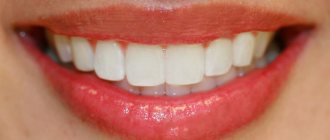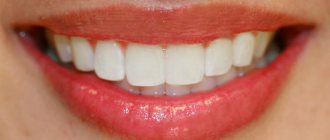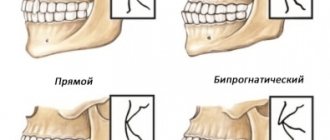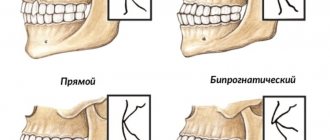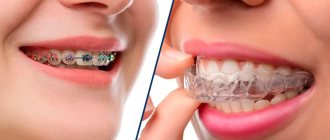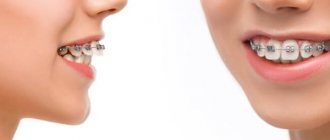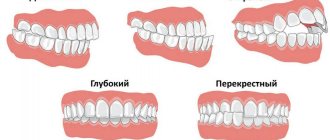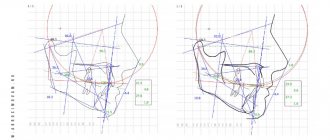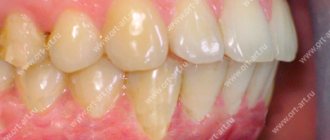How a bite is formed What a correct bite looks like Types Definition of a bite Possible consequences Methods of correction
Teeth bite is the relative arrangement of the dentition when the jaws are completely closed.
The formation of the dental system begins in intrauterine development. By the 11th week, the fetus has jaw stripes. Almost all children are born with malocclusion. The lower jaw is moved back. Dentists call this phenomenon retrognathia. When a baby actively sucks, the muscles are trained. By 6-8 months with breastfeeding, and a little later, with artificial feeding, the lower jaw takes the correct position. For bottle-fed children, it is necessary to monitor the position of the body and the hole in the nipple. If the formula does not flow from the bottle, you have to make an effort to get it, the child’s tongue and jaw muscles receive sufficient stress and malocclusions can be avoided.
Stages of bite formation
The first stage is completed by the time teeth erupt. Then it is formed:
- Temporary bite
Period: from 6 months to 3 years
. Teeth are actively growing, their relationship in the jaw is changing. When all the teeth have erupted, the stage of a formed temporary bite begins. It lasts until the moment when baby teeth begin to be replaced by permanent ones. The number of teeth is 20. Their location is influenced by the child’s habits: thumb sucking, sucking a corner of a bedspread, long-term use of a pacifier. Most causes of pathologies appear at this age.
- Replaceable (mixed)
Period: 6-14 years
. The active growth of permanent teeth increases the bite and promotes changes in the position of the jaw relative to each other. The jaws are in the process of formation. This is the ideal time for orthodontic treatment.
- Constant
Once all the baby teeth have fallen out, the bite becomes permanent. Number of teeth 28-32. With the appearance of fangs, the bite increases again.
The final formation of the jaws is completed by the age of 21, but the movement of teeth continues throughout life. The teeth are worn down by the friction of the side parts, because of this their position in the jaw changes, although we do not notice it. Dentists call this process mesial movement.
How does bite development occur?
The bite develops along with the teeth, so it is very important to monitor the condition of the child’s baby teeth, since already at this stage, under a number of prerequisites, formation disorders may appear. The position of the tongue also affects the bite; if the position is incorrect, distortions in the rotation and inclination of the teeth are possible.
There are five main life stages during which the formation of a normal bite occurs:
- In the first six months of a newborn’s life, the foundations are laid for the correct closure of the dentition, if a natural method of feeding is used: chewing muscles, the activity of the lower jaw arch increases, the foundations for the correct development of the oral cavity are laid, the position of the tongue is focused on the lips and cheeks.
- At six months, the child begins to cut his first milk teeth with thin roots and a roller-shaped crown, which are absorbed by the time the permanent teeth emerge. The tongue rests on the roof of the mouth.
- By the age of three, temporary teeth have been formed, ensuring the full functioning of the dental arches, allowing chewing food and speaking. From the age of four, the primary bite gradually begins to fade - the protruding parts of the teeth are worn away, the incisal overlap becomes smaller.
- At the age of six, the replacement of teeth from milk to permanent ones begins. The overlap of the bottom row is normally no more than one third. If during the formation of baby teeth or after their loss, gaps have formed between the teeth, called tremata and diastemas, at this stage they disappear.
- By the age of fifteen, a teenager completes the full formation of dental arches. The norm is full contact of both dentitions when chewing, excluding the first lower incisors and wisdom teeth that appear later.
Malocclusion problems later in life are most often due to developmental errors at one of these five stages. For example, some children can jokingly push their lower jaw forward - this seemingly harmless movement can affect the distortion of the bite. An experienced dentist is able to help stop incorrect actions at an early stage and teach the child the correct position of the jaw, to facilitate learning - in the same playful way.
Parental attentiveness also plays an important role. After the first six months of a baby's life, when the child's first teeth begin to cut, it is imperative to eliminate prolonged use of a pacifier and prohibit the child from keeping a finger in his mouth. Otherwise, these actions will lead to the appearance of a so-called open bite.
What does a correct teeth bite look like?
Physiological (correct) occlusion in humans is characterized by:
- adequate form of dentition. The top one looks like a semi-ellipse, the bottom one resembles a parabola;
- the upper incisors overlap the lower ones by ⅓ of the height;
- there is contact between all teeth;
- the lower teeth are vertical, the upper teeth are inclined;
- each tooth, except 4, has 2 antagonists (one opposite);
- the correct bite in the diagram is marked by the symmetry of the incisors;
- chewing teeth are in contact with each other.
Correct bite in adults has its own variations. All of them are considered a variant of the norm:
- Orthognathic
. The upper teeth slightly overlap the lower teeth, and all molars and premolars occlude. - Straight
. The upper teeth do not overlap the lower ones, but join with them. The lateral teeth meet well. - Physiological progeny
. The lower teeth protrude beyond the upper teeth, but contact is maintained. The lateral teeth close together without gaps. - Biprognathic
. The incisors of both jaws are inclined forward, with intact contact.
Dental laboratory. Features of manufacturing orthodontic crowns
EDUCATIONAL MATERIAL
The base plate is the basis of removable appliances and dentures. As an independent device, it is used to retain the achieved results of orthodontic treatment. The design, consisting of a base plate with active elements, refers to single-jaw mechanically operating devices. Functional guide parts can be attached to the base plate. When rubber rods or springs are strengthened on the upper and lower base plates, they turn into mechanically operating devices of intermaxillary action. Basic plates connected into a single block are the basis for the design of two-jaw functional block and frame devices.
Single-jaw and monoblock orthodontic appliances, appliances with inclined planes, as well as removable dentures are often prepared using the method of hot polymerization of plastic.
The sequence of manufacturing a removable single-jaw orthodontic appliance by hot polymerization of plastic by boiling a cuvette in water is as follows:
I. Clinical stage:
Taking an impression from the upper or lower jaw and casting a working model.
II. Laboratory stage:
| Then proceed to | bending of fixings, | mechanically |
| acting wire | parts and strengthen them with melted wax |
on the model. Heat the wax plate and press it tightly onto the surface of the plaster model. The thickness of the base plate is 2 - 2.5 mm.
To make a base plate for the upper jaw, the palate and palatal surface of the teeth are covered with wax to the level of their chewing teeth.
surfaces and cutting edges. The posterior edge of the base ends on the line connecting the distal surfaces of the last molars.
When making a base plate for the lower jaw, the upper and posterior borders are the same as on the upper jaw, the lower border is located in the sublingual region at the junction of the alveolar process and the floor of the mouth. In the anterior section of the base plate, a notch is made for the frenulum of the tongue.
If it is necessary to make a device with a screw, soften the wax and strengthen the screw in the right place, in which a fixing bracket has been previously inserted, the holes and threads are insulated.
A removable apparatus, modeled from wax, is plastered together with the model in a ditch in order to replace the wax with plastic.
The cuvette is a metal box consisting of two halves and two lids (Figure 61).
In the manufacture of orthodontic appliances, direct and combined methods of plaster casting are used. With the direct method, the model and wire parts remain in one part of the cuvette after the wax is melted.
The height of the model should be such that the teeth do not rise above the level of the sides of the lower half of the ditch. For better strengthening in
plaster of clasps, vestibular arches and other parts, it is recommended to cut off part of the plaster tooth with a spatula so that there is free space for filling with gypsum.
Before plastering, the model is immersed in cold water for 3 to 5 minutes. The base of the cuvette is filled with plaster, and the model, with preliminary
teeth, clasps, arches covered with plaster, are immersed in a ditch so that the plate covering the palate or alveolar process on the lingual side remains free (Figure 62).
Excess plaster is removed and the surface is smoothed so that nothing interferes with the separation of the cuvette. An insulating layer is applied to the plaster; both halves of the cuvette are folded together and the cuvette is filled with plaster, covered with a lid, placed under a press (Figure 63) so that all parts are tightly connected; Excess gypsum is forced out.
Knead the plastic according to the instructions and after it swells (does not stick to the spatula), form a base in a cuvette cooled to room temperature. Connect both parts of the cuvette and press them tightly; after 3 minutes of holding under pressure, immediately screw them into a metal clasp and place them in a vessel with water at room temperature; the water is brought to a boil, boiling should continue for 60 minutes, after which the heating is stopped and the cuvette is left in hot water for 15 minutes. After cooling the cuvette in air or in water at room temperature, they begin to remove the apparatus from the cuvette. The apparatus, cleaned of plaster, is ground and polished.
III. Clinical stage. Applying the device to the patient.
Clinical and laboratory stages of manufacturing a bimaxillary apparatus:
I. Clinical stage. Obtaining impressions from both jaws and casting working models.
II. Laboratory stage. Making a wax base using an occlusal roller on a model of the upper jaw. The model is covered with a release varnish (isokol, etc.), the wax plate is softened and the hard palate and teeth are pressed onto it; excess wax is cut off hot
with a spatula. The occlusal roller is made from a heated wax plate,
rolled up in several layers. Its height is 1 - 1.5 cm, width - 1 cm. The roller is fastened to the base with molten wax, smoothing out all the irregularities.
III. Clinical stage. Determination of constructive bite (Figure 64).
Figure 64. Making a wax template and determining the constructive bite
The constructive bite is determined in three planes:
- in the sagittal - in most cases the patient is asked to displace the n/person. to the neutral position of the lateral teeth;
- in the vertical - separate the lateral teeth by 3 - 5 mm;
- in the horizontal - make sure that the line passing between the central incisors of the upper and lower jaws coincides.
The wax base is introduced into the oral cavity and the occlusal roller is gradually adjusted, not heating it, but cutting off excess wax to the required position of the jaws. Then cut off an even layer of wax
from the occlusal roller and replace it with a strip of softened wax. The base is again introduced into the oral cavity and the patient is asked to close his teeth; using the dental imprints obtained on the occlusal roller, they are guided when
compiling models.
IV. Laboratory stage.
After determining the constructive bite of the model
plastered in an occluder: a little mixed plaster is poured onto the table,
The lower arch of the occluder is immersed in plaster and, adding another layer of plaster on top of the arch, the lower model is placed on it. A new portion of plaster is poured onto the upper model and, lowering the upper arch of the occluder onto it, it is filled with plaster. Models with occlusal ridges are pre-glued using wax strips.
When the gypsum hardens, cut off the excess. It is also necessary to ensure that the rod that fixes the height of the bite rests against the platform on the lower arch of the occluder. If the wax base with occlusal ridges is removed, the relative position of the models in the constructive bite remains fixed in the occludator.
Then the wire elements (arcs, springs, clasps, etc.) are bent and strengthened with wax on the model; model the bases of the apparatus on models of the upper and lower jaws, connecting them along the occlusal plane. Plaster models, together with the wax composition of the apparatus, are separated from the occluder and plastered into a cuvette.
In the manufacture of double-jawed devices, a high cuvette is required; if one is not available, one and a half ordinary cuvettes are used (2 bases
and 1 counter).
In cases where the length of the model does not exceed the height of the base of the cuvette, a regular cuvette can be used. They use the direct method of plaster casting, immersing the models with the front teeth down. The cuvette is opened after the wax has softened to avoid breakage of the plaster parts. Place the cuvette in boiling water for 5 minutes.
If the direct method of plaster is used, both models and all wire parts are located at the base of the ditch.
If 1.5 cuvettes are used, the models along with the wire parts are located in different parts of the cuvettes. The subsequent steps coincide with those described earlier.
Expanding plates with screws and clasps, retention plates, dental and chin guards, sports splints, bite bases, retainers, positioners and other devices are prepared in Biostar, Ministar, etc. machines, in which they are stamped from heated plastic plates using a vacuum. Single-jaw plates with a large number of springs, levers, dental arches, screws, as well as double-jaw frame devices are prepared mainly by the method of cold polymerization of self-hardening plastic under increased pressure.
Other types of occlusion in dentistry
There are 3 large groups of bites.
- Normal
(physiological). These bites have several variations, but the teeth are closed, the jaws are in the correct position, and the teeth are symmetrical along the incisors. - Anomalous
. Congenital defects caused by harmful effects on the fetus during pregnancy or genetic disorders - Pathological
. Defects acquired after teething as a result of disease, missing units, or displacement of teeth.
In life, the last two concepts are often mixed and replace each other. Based on the relationship between teeth and jaws, the following types of bite are distinguished:
Deep
The upper teeth cover the upper ones by more than ⅓. The contact between the teeth is broken. This leads to impaired chewing function, abnormal enlargement of the upper jaw, and disruption of the anatomical structure of the face. The second name for this defect is traumatic. As a result of pathology, the functioning of the temporomandibular joint is often disrupted, the mucous membranes are injured, and the enamel is pathologically erased. This is the most common pathology.
Open
The teeth do not close completely. The defect can be frontal or lateral. This pathology is characterized by impaired diction, chewing, and swallowing. Mouth breathing is observed, hence drying out of the mucous membrane and frequent caries.
Distal
With this defect, the upper jaw is strongly pushed forward. The front teeth do not occlude, and the occlusion of the rear teeth is broken. Characterized by problems with breathing, chewing, and swallowing. Patients complain of joint pain, frequent caries, and periodontal disease.
Mesial
When the lower jaw is pushed forward, they speak of progeny or mesial occlusion. This jaw bite pathology is accompanied by diastemas (large gaps between the front teeth) or trema (gaps between any teeth). Often patients have crooked lower teeth, they are crowded, and there is increased deposit of tartar.
Crossbite
Some units overlap each other. Difficult to treat, surgical intervention is often used. It is characterized by facial deformation, speech defects, disruption of chewing function and the functioning of the TMJ. Patients complain of constant biting of the cheeks and tongue.
All pathological forms of bites in orthodontics are recommended for correction with removable (for baby teeth) and non-removable structures (braces), and aligners.
Determination methods
Model impressions used by orthodontists to determine the constructive bite are formed by partially shifting the lower jaw in the desired direction, depending on the specifics of the existing defect. Wax templates allow you to obtain an imprint of the position, based on which the correction device is developed.
One of the most common methods of orthodontic diagnosis is the Pon method, which allows one to determine the normative value of the width of the jaw arches. The measurements provided for by the protocol help to establish the narrowing index of the row, differentiated into three degrees - up to 4, up to 6 and over 6 mm.
Another option is the Snagina method, the specifics of which are determined by the mandatory presence of all elements of the dentition (that is, the absence of edentulous areas), as well as the requirements for creating a model. Only if the specified conditions are met is it possible to take measurements of the maxillary region.
The Nance method is used to assess the degree of shortening of the dental arch from the point of view of the occlusal plane. In this case, there are also three degrees of development of anomalies:
- From one to five millimeters.
- Up to seven millimeters.
- Above specified values.
Based on the diagnostic results, a correction method is determined that takes into account the specifics of the anatomical structure and allows you to restore the natural ratio.
Determination of dental occlusion
Often problems with bite are obvious, but it also happens that everything looks normal on the outside, but there is a problem. Therefore, it is better to entrust the determination of the bite to the dentist. They use special methods to determine correct or incorrect bite and prescribe treatment.
Diagnostics include:
- Clinical examination
The orthodontist collects anamnesis, conducts a general examination and examines the oral cavity and nasopharynx. They examine breathing, speech formation, swallowing, chewing, biting.
- X-ray examination
A panoramic X-ray or CT scan allows you to identify skeletal abnormalities, see the exact location of the teeth, the condition of the roots, and bone tissue.
- Biometric test
The doctor examines the jaws, takes and records all measurements.
- Functional test
Examination in a stationary position, while talking, opening the mouth in the lateral and frontal projection.
It is impossible to put the jaw back in place on your own, but the sooner the intervention begins, the better the result. It is very difficult to restore the correct position of teeth after 25 years; it is better to do this while the bite is forming.
Causes of malocclusion
The formation of a bite is a complex and lengthy process that begins at the stage of intrauterine development and ends only when a person reaches puberty.
- Genetic factor. One of the leading reasons for the formation of malocclusion is heredity, which determines the size and shape of the teeth, the width and length of the dentition, the height of the hard palate, as well as the nature of the location of the teeth (sparse or crowded).
- Quality of nutrition and maternal diseases during pregnancy.
- Birth injury. Jaw injuries received during childbirth lead to displacement of the temporomandibular joint, and subsequently to the formation of a pathological bite.
- Incorrect selection of nipples during artificial feeding, when the child does not make enough effort to obtain milk, as when sucking at the breast, which causes underdevelopment of the lower jaw.
- Untimely introduction of solid foods into the diet during teething. In the absence of chewing, the muscles of the dentofacial apparatus, on which the development of the jaws largely depends, are not strengthened.
- Behavioral factors: sucking pacifier, upper lip, fingers; sleep with the head thrown back.
- Irregularities in the timing and sequence of teething.
- ENT pathologies due to which the child is forced to breathe through the mouth for a long time: chronic rhinitis, sinusitis, deviated nasal septum, adenoids.
- Diseases affecting bone growth and development.
All these factors can cause improper closure of the dentition and form a pathological bite.
Consequences
The influence of bite on the condition of the dental system and the entire body is enormous.
Bite pathologies lead to:
- Loss of teeth. Uneven chewing load leads to cracks and chips. Bacteria penetrate through the damaged enamel layer, affecting periodontal tissue. Periodontitis develops. Teeth become loose and fall out. The risk of caries in such cases is higher than in people without defects.
- Disorders of the temporomandibular joint (TMJ). It begins to click, hurt, and in severe cases, dislocation is possible.
- Due to crowded teeth, plaque and tartar quickly form, which provokes gingivitis and periodontitis.
- Insufficient contact between teeth leads to food being poorly chewed. As a result, problems arise with the gastrointestinal tract.
- Oral, impaired breathing causes diseases of the respiratory system.
- The position of the jaws affects posture. An abnormal movement of the jaw forward shifts the center of gravity, the position of the neck changes, the chest collapses, and the person begins to stoop. Muscle tone is impaired and back pain begins.
- An incorrect bite distorts facial features and disrupts its symmetry.
Anomalies of the jaws affect the psychological state. The person withdraws into himself and avoids company. Depressive states are common.
Orthodontic treatment restores physical and emotional balance and helps improve self-esteem.
How to identify malocclusions?
Only a qualified specialist can make an accurate conclusion about whether there were disturbances in the formation of the bite. For this purpose, the orthodontist prescribes radiography of the dental system. However, a number of factors can indicate existing problems and help take appropriate measures aimed at the timely identification and elimination of defects in the development of occlusion. You should be concerned if you notice one or more of the following signs:
- permanent appearance of heavy plaque in the same areas,
- bleeding of gum tissue,
- pronounced displacement of the jaw arch,
- Difficulty pronouncing sibilants.
Plaque formed in the same areas indicates that these areas are not involved in chewing food, which may indicate a malocclusion. You should also pay attention to the condition of your dental arches even if there are significant distances between the teeth, uneven placement of teeth, crowded arrangement, etc.
Characteristics of normal physiological occlusion:
- the central distance between the incisors on both jaws is the same,
- the upper cone-shaped teeth (fangs) cover the lower ones by no more than 1/3,
- chew food equally comfortably on the left and right,
- symmetrical lower part of the facial oval.
To determine the absence of pathologies, you can close your jaw and open your lips in front of a mirror - if the teeth are completely in contact and the top row is slightly pushed forward, then the bite is normal.
